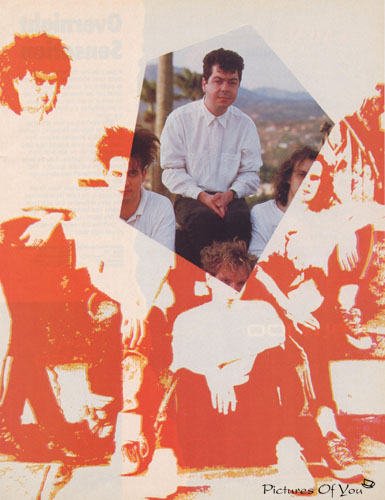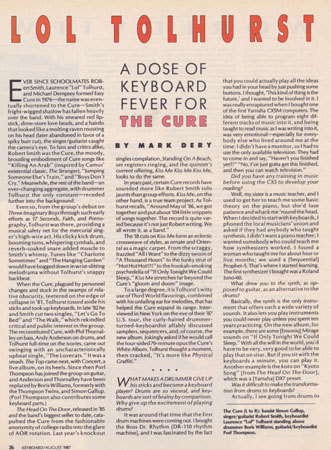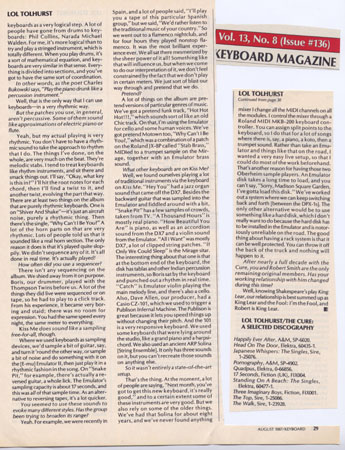"A Dose Of Keyboard Fever"

August 1987 ~
Keyboard (USA)
"A Dose Of Keyboard Fever"



August 1987 ~
Keyboard (USA)
"A Dose Of Keyboard Fever"
Ever since schoolmates
Robert Smith, Laurence "Lol" Tolhurst, and Michael Dempsey formed Easy Cure in
1976 -- the name was eventually shortened to the Cure -- Smith's fright-wigged
shadow has fallen heavily over the band. With his smeared red lipstick,
dime-store love beads, and a hairdo that looked like a molting raven roosting on
his head (later abandoned in favor of a spiky burr cut), the singer/guitarist
caught the camera's eye. To fans and critics alike, Robert Smith was the Cure,
the moody, brooding embodiment of Cure songs like "Killing an Arab" (inspired by
Camus' existential classic, "The Stranger"), "Jumping Someone Else's Train," and
"Boys Don't Cry." Meanwhile, the rest of the band -- an ever-changing aggregate,
with drummer Tolhurst the only constant -- receded further into the background.
Even so, from the group's debut on Three Imaginary Boys through such early efforts as 17 Seconds, Faith and Pornography, Tolhurst was there, providing a musical safety net for the mercurial singer's high-wire act. His clicky kick drum, booming toms, whispering cymbals, and reverb-soaked snare added muscle to Smith's whimsy. Tunes like "Charlotte Sometimes" and "The Hanging Garden" would have bogged down in wrist-slitting melodrama without Tolhurst's snappy backbeat.
When the Cure, plagued by personnel changes and stuck in the swamps of relative obscurity, teetered on the edge of collapse in '81, Tolhurst tossed aside his sticks and took up keyboards. [Note from nancy - the "edge of collapse" really occurred in the summer of '82.] In late '82 he and Smith cut two singles, "Let's Go To Bed" and "The Walk," which rekindled critical and public interest in the group. The reconstituted Cure, with Phil Thornalley on bass, Andy Anderson on drums, and Tolhurst full-time on the ivories, came out swinging with an uncharacteristically upbeat single, "The Lovecats." It was a smash. The Top came next, with Concert, a live album, on its heels. Since then Porl Thompson has joined the group on guitar, and Anderson and Thornalley have been replaced by Boris Williams, formerly with the Thompson Twins, and Simon Gallup. (Porl Thompson also contributes some keyboard parts.)
The Head On The Door, released in '85 and the band's biggest seller to date, catapulted the Cure from the fashionable anonymity of college radio into the glare of AOR rotation. Last year's knockout singles compilation, Standing on a Beach, set registers ringing, and the quintet's current offering, Kiss Me Kiss Me Kiss Me, looks to do the same.
In years past, certain Cure records have sounded more like Robert Smith solo jaunts than group efforts. Kiss Me, on the other hand, is a true team project. As Tolhurst recalls, "Around May of '86, we got together and put about 104 little snippets of songs together. The record is quite varied because it's not just Robert writing. We all wrote it, as a band."
The 18 cuts on Kiss Me form an eclectic crossweave of styles, as ornate and Oriental as a magic carpet. From the scraggy, frazzled "All I Want" to the dizzy swoon of "A Thousand Hours" to the funky strut of "Hot Hot Hot!!!" to the hookah-smoking psychedelia of "If Only Tonight We Could Sleep," Kiss Me stretched far beyond the Cure's "gloom and doom" image.
To a large degree, it is Tolhurst's witty use of Third World flavorings, combined with his unfailing ear for melodies, that has helped the Cure expand its range. Interviewed in New York on the eve of their '87 U.S. tour, the curly-haired drummer-turned-keyboardist affably discussed samplers, sequencers, and, of course, the new album. Jokingly asked if he would call the four-sided 70-minute opus the Cure's *White Album*, Tolhurst thought a moment, then cracked, "It's more like *Physical Graffiti."
Keyboard: What makes a drummer give up his sticks and become a keyboard player? Drums are so visceral, and keyboards are sort of brainy by comparison. Why give up the excitement of playing drums?
Lol: It was around that time that the first drum machines were coming out. I bought the Boss Dr. Rhythm [DR-110 rhythm machine], and I was fascinated by the fact that you could actually play all the ideas you had in your head by just pushing some buttons. I though, 'This kind of thing is the future,' and I wanted to be involved in it. I was really enraptured when I bought one of the first Yamaha CX5M computers. The idea of being able to program eight different tracks of music into it, and being taught to read music as I was writing into it, was very emotional -- especially for everybody else who lived around me at the time. I didn't have a monitor, so I had to use the only available television. They had to come in and say, "Haven't you finished yet?!" "No, I've just gotta get this finished, and then you can watch television."
Keyboard : Did you have any training in music before using the CX5 to develop your reading?
Lol: Well, my sister is a music teacher, and I used to get her to teach me some basic theory on the piano, but she'd lose patience and whack me 'round the head. When I decided to start with keyboards, I phoned the local musicians' union and asked if they had anybody who taught synthesis. I didn't want a piano teacher; I wanted somebody who could teach me how synthesizers worked. I found a woman who taught me for about four or five months; we used a [Sequential] Prophet-5. That's where I started learning. The first synthesizer I bought was a Roland Juno-60.
Keyboard : What drew you to the synth, as opposed to the guitar, as an alternative to the drums?
Lol: Basically, the synth is the only instrument that offers such a wide variety of sounds. It also lets you play instruments you could never play unless you spent ten years practicing. On the new album, for example, there are some [Ensoniq] Mirage sounds on "If Only Tonight We Could Sleep." With all the will in the world, you'd have to be very, very good to be able to play that on a sitar. But if you sit with the keyboards a minute, you can play it. Another example is the koto on "Kyoto Song" [from *The Head On The Door*], which was a [Yamaha] DX7 preset.
Keyboard : Was it difficult to make the transformation from drums to keyboards?
Lol: Actually, I see going from drums to keyboards as a very logical step. A lot of people have gone from drums to keyboards: Phil Collins, Narada Michael Walden. For me, it's more logical than to try to play a stringed instrument, which is totally different. When you play drums, it's a sort of mathematical equation, and keyboards are very similar in that sense. Everything is divided up into sections, and you've got to have the same sort of coordination.
Keyboard : In other words, as the poet Charles Bukowski says, "Play the piano drunk like a percussion instrument."
Lol: Well, that is the only way I can use keyboards -- in a very rhythmic way.
Keyboard : But the patches you use, in general, aren't percussive. Some of them sound like approximations of electric piano or flute.
Lol: Yeah, but my actual playing is very rhythmic. You don't have to have a rhythmic sound to take the approach to rhythm that I do. The things I've done, on the whole, are very much on the beat. They're melodic stabs. I tend to treat the keyboards like rhythm instruments, and sit there and smack things out. I'll say, "Okay, what key is this in?" I'll hit the root notes for each chord, then I'll find a twist to it, and another twist, evolving the part that way. There are at least two things on the album that are purely rhythmic keyboards. One is on "Shiver and Shake" -- it's just an aircraft noise, purely a rhythmic thing. Then there's the single, "Why Can't I Be You?" A lot of the horn parts on that are very rhythmic. Lots of people told us that it sounded like a real horn section. The only reason it does is that it's played quite sloppily. We didn't sequence any of it. It's all done in real time. It's actually *played*!
Keyboard : How often did you use a sequencer?
Lol: There isn't any sequencing on the album. We shied away from it on purpose. Boris, our drummer, played with the Thompson Twins before us. A lot of the things they did live were sequenced or on tape, so he had to play to a click track. From his experience, it became very boring and staid; there was no room for expression. You had the same speed every night, the same meter to everything.
Keyboard : Kiss Me does sound like a sampling free-for-all, though.
Lol: Where we used keyboards as sampling devices, we'd sample a bit of guitar, say, and turn it 'round the other way, or sample a bit of noise and do something with it on the [E-mu] Emulator II, then just play it in a rhythmic fashion in the song. On "Snake Pit," for example, there's actually a reversed guitar, a whole lick. The Emulator's sampling capacity is about 17 seconds [nancy - "a measure of life"], and this was *all* of that sample time. As an alternative to reversing tapes, it's a lot quicker.
Keyboard : You seemed to use these sounds to evoke many different styles. Has the group been trying to broaden its range?
Lol: Yeah. For example, we were recently in Spain, and a lot of people said, "I'll play you a tape of this particular Spanish group," but we said, "We'd rather listen to the traditional music of your country." So we went out to a flamenco nightclub, and for four hours they played nonstop flamenco. It was the most brilliant experience ever. We all sat there mesmerized by the sheer power of it all! Something like that will influence us, but when we come to do our interpretation of it, we don't feel constrained by the fact that we don't play in certain meters. We just sort of blast our way through and pretend that we do.
Keyboard : Pretend?
Lol: A lot of things on the album are pretend versions of particular genres of music. We've got a pretend funk track, "Hot Hot Hot!!!," which sounds sort of like an old Chic track. On that, I'm using the Emulator for cello and some human voices. We've got pretend Motown too, "Why Can't I Be You?," which was a combination of a patch on the Roland JX-8P called "Stab Brass," MIDIed to a trumpet sample on the Mirage, together with and Emulator brass sound.
Keyboard : What other keyboards are on Kiss Me?
Lol: Well, we found ourselves playing a lot of traditional instruments via the keyboard on Kiss Me. "Hey You" had a jazz organ sound that came off the DX7. Besides the backward guitar that was sampled into the Emulator and fiddled around with a bit, "Snake Pit" has a few samples of crowds, taken from TV. "A Thousand Hours" is mostly real piano. "How Beautiful You Are" is piano, as well as an accordion sound from the DX7 and a violin sound from the Emulator. "All I Want" was mostly DX7, a lot of clipped string patches. "If Only We Could Sleep" is the Mirage sitar. The interesting thing about that one is that at the bottom end of the keyboard, the disk has tablas and other Indian percussion instruments, so Boris sat by the keyboard and punched out a rhythm in real time. "Catch" is Emulator violin playing the main melody line, and there's also a cello. Also, Dave Allen, our producer, had a Casio CZ-101, which we used to trigger a Publison Infernal Machine. The Publison is great because it lets you speed things up without changing their pitch. And the 101 is a very responsive keyboard. We used some keyboards that were lying around the studio, like a grand piano, and a harpsichord. We also used an ancient ARP Solina [String Ensemble]. It only has three sounds on it, but you can't recreate those sounds on anything else.
Keyboard : So it wasn't entirely a state-of-the-art setup.
Lol: That's the thing. At the moment, a lot of people are saying, "Next month, you've got to get this new keyboard, it's really good," and to a certain extent some of these instruments *are* very good. But we also rely on some of the older things. We've had that Solina for about eight years, and we've never found anything that could supersede it. We used to have an old Roland string machine as well, an SH-09 or something like that. Particularly on string sounds, we've found that instruments like the DX7 don't create such a full or rich sound as a lot of the old analog synthesizers do. That's why people are bringing out samples now of old analog synths. You can get a Minimoog sample, an ARP sample, things like that. A lot of the sounds on some of the FM keyboards are very clean and bright, but they don't have much guts about them.
Keyboard : Which keyboard do you most enjoy playing?
Lol: I'm most comfortable on the DX7 because it's got the easiest keyboard to play. It's definitely not the easiest to program, but in a live situation as well as in the studio, that's the one I use, MIDIing other things to it.
Keyboard : Did you do much programming on Kiss Me?
Lol: The most we did was shorten attack or increase sustain. A lot of the time, when people sample things like cellos or violins, they don't actually take into consideration what a real cello or violin sounds like. So I find myself modifying those parameters. You're playing a keyboard as opposed to the instrument itself, so you have to allow for that little delay in time between when you press the key down and when the sound actually comes. I've got this Sound Designer software by Digidesign, and when we put up a sound with it in the studio, we chopped bits off of it. It's very similar to the Fairlight, except that instead of a pen, you have a mouse, with which you can change the waveform slightly. Also, we shifted sounds around a bit, so that they would sound realistic throughout the length of the keyboard. For live sounds, before our tour began in July, my roadie, Bruno Brunning, and I spent about five days together, programming all the disks. He's very good at programming.
Keyboard : What do you look for in putting together an onstage setup?
Lol: The thing I really want is a keyboard setup that is not complicated to use in a live situation. Unfortunately, with a lot of the things we've been using in the studio, I've got to think of how to do it live. That's the greatest problem that a lot of keyboard players face. Nobody has yet come out with a system that can be utilized equally well in the studio and live.
Keyboard : What are you playing on your '87 tour?
Lol: I'm using a rack system, composed of two Oberheim DPX-1 sample players, which play Mirage, Prophet, and Emulator disks. I've also got a rack-mounted DX7, a Roland digital piano module, a Roland Super Jupiter module, and a Roland DP-5 multi-effects unit. It's all controlled by a Simmons computer mixer, which has about 64 programs in it. Through that mixer I change all the MIDI channels on all the modules. I control the mixer through a Roland MIDI MKB-200 keyboard controller. You can assign split points to the keyboard, so I do that for a lot of songs where there is, say, a piano, a koto, then a trumpet sound. Rather than take an Emulator and things like that on the road, I wanted a very easy live setup, so that I could do most of the work beforehand. That's another reason for having those two Oberheim sample players. An Emulator disk takes a long time to load, and you can't say, "Sorry, Madison Square Garden, I've gotta load this disk." We've worked out a system where we can keep switching back and forth [between the DPX-1s]. The only other alternative would be to use something like a hard disk, which I don't really want to do because the hard disk has to be installed in the Emulator and is notoriously unreliable on the road. The good thing about having a rack system is that it can be well protected. You can throw it off the back of the truck and nothing will happen to it.
Keyboard : After nearly a full decade with the Cure, you and Robert Smith are the only remaining original members. Has your working relationship with him changed during this time?
Lol: Well, knowing Shakespeare's play *King Lear*, our relationship is best summed up as King Lear and the Fool: I'm the Fool, and Robert is King Lear.